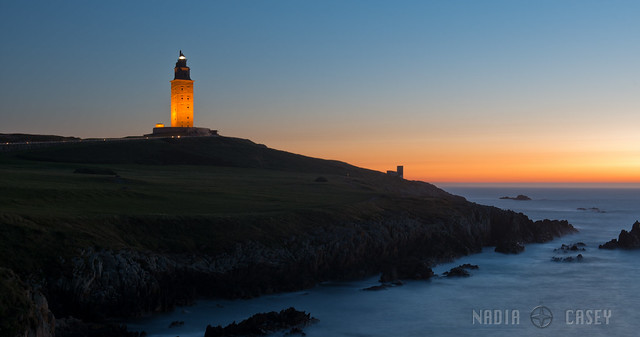
Tucked away in the Northwest corner of the Iberian Peninsula is one of Europe's best kept secrets. Galicia's culinary delights, green landscapes, fantastic architecture, rich history and culture is well known to the people of Spain, but when most outsiders think of the riches of European travel, Galicia hardly receives a word. Even when people think of Spain, more often than not they think of places like Andalucia or Barcelona. In all aspects of travel Galicia can hold its own and delight even the most seasoned traveler. Galicia is a very unique region of Spain known for its wet climate and fantastic seafood, and it shares a number of cultural similarities with the British Isles. The Celtic origins of Galicia are evident in many aspects of traditional life, and combined with the rain and green countryside, one might think it's geographically closer to Dublin than to Madrid.
One of the many things that make Galicia so wonderful and very unique is that even though there are hints of its Celtic past, the mix of both Spanish and Portuguese life is on full display. One of many places where the Iberian culture and history takes center stage is the incredible city of Santiago de Compostela. This city can rival any of Europe's best when it comes to beautiful medieval architecture and little stone-paved streets. The Cathedral is among the most inspiring man-made structures we have ever had the fortune to visit, and for the few days we had to be there it was like living in a dream.
- Hercules Tower - A Coruña, Spain -
~ Galicia ~

Galicia sits above Portugal and faces the Atlantic Ocean, giving it a more temperate climate, making it suitable to base its economy on agriculture and fishing. Most of the local fishing consists of shellfish and crustaceans, for which the region is internationally renowned. It is also culturally defined by its abundant and interesting history and traditions, and when all is considered, this is a place that gives you the opportunity to be away from the commercialism that so heavily affects so many other European holiday destinations, giving you a "real" taste of Spain.
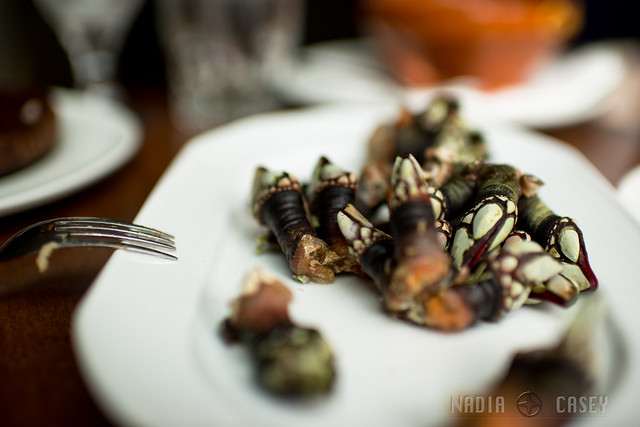
Percebes
Goose Barnacles are filter-feeding crustaceans that live attached to hard surfaces of rocks in the ocean. They are a widely consumed in Portugal and Spain as an expensive delicacy known as percebes. Percebes are harvested commercially in the northern coast, mainly in Galicia.
(wiki)
~ A Coruña ~
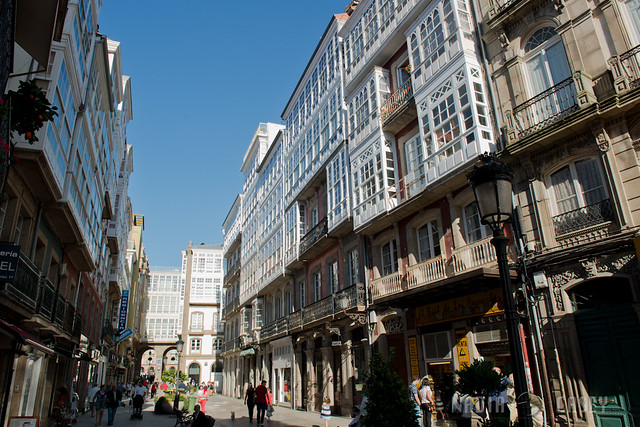
A Coruña Main Street Daytime
The city is famous for its glazed windows, of which there are so many that it is sometimes referred to as a glass city.

Main Street A Coruña
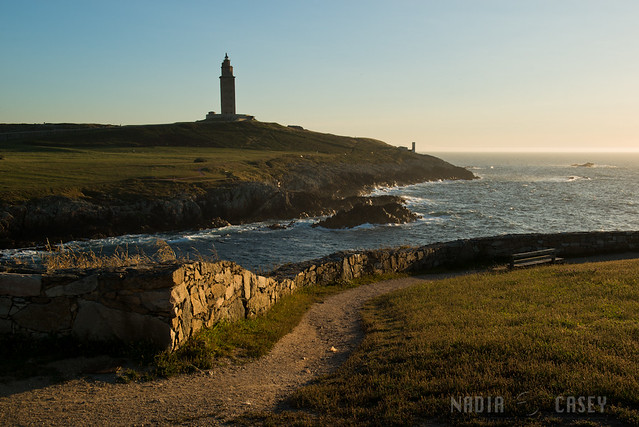
The Tower of Hercules
A Coruña is a city in Galicia and home to the Tower of Hercules, an ancient Roman lighthouse said to be modeled after the lighthouse in Alexandria. It is the oldest Roman lighthouse in use today and is known to have existed by the 2nd century and given a restoration in 1788.
"A legend embodied in the 11th-century Irish compilation Lebor Gabála Érenn— the "Book of Invasions"— King Breogán, the founding father of the Galician Celtic nation, constructed here a massive tower of such a grand height that his sons could see a distant green shore from its top. The glimpse of that distant green land lured them to sail north to Ireland. According to the legend, these Breogán's descendants who stayed in Ireland and their followers are the Celtic ancestors of the current Irish people. A colossal statue of Breogán has been erected near the Tower."
(wiki)
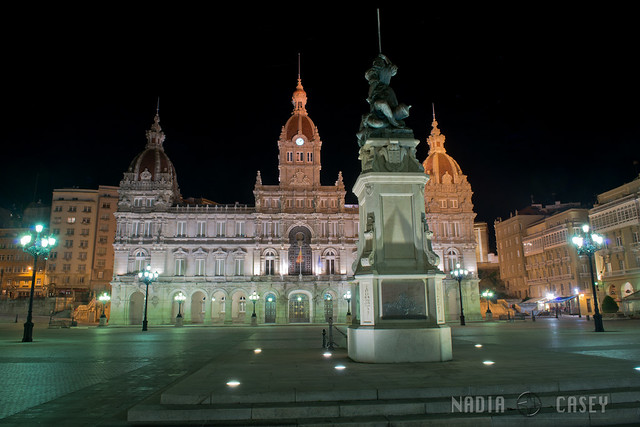
City Hall in the Maria Pita Square, A Coruña

Galicia Shells
A Coruña, SpainGalicia sits above Portugal and faces the Atlantic Ocean, giving it a more temperate climate, making it suitable to base its economy on agriculture and fishing. Most of the local fishing consists of shellfish and crustaceans, for which the region is internationally renowned. It is also culturally defined by its abundant and interesting history and traditions, and when all is considered, this is a place that gives you the opportunity to be away from the commercialism that so heavily affects so many other European holiday destinations, giving you a "real" taste of Spain.

Percebes
Goose Barnacles are filter-feeding crustaceans that live attached to hard surfaces of rocks in the ocean. They are a widely consumed in Portugal and Spain as an expensive delicacy known as percebes. Percebes are harvested commercially in the northern coast, mainly in Galicia.
(wiki)
~ A Coruña ~

A Coruña Main Street Daytime
The city is famous for its glazed windows, of which there are so many that it is sometimes referred to as a glass city.

Main Street A Coruña

The Tower of Hercules
A Coruña is a city in Galicia and home to the Tower of Hercules, an ancient Roman lighthouse said to be modeled after the lighthouse in Alexandria. It is the oldest Roman lighthouse in use today and is known to have existed by the 2nd century and given a restoration in 1788.
"A legend embodied in the 11th-century Irish compilation Lebor Gabála Érenn— the "Book of Invasions"— King Breogán, the founding father of the Galician Celtic nation, constructed here a massive tower of such a grand height that his sons could see a distant green shore from its top. The glimpse of that distant green land lured them to sail north to Ireland. According to the legend, these Breogán's descendants who stayed in Ireland and their followers are the Celtic ancestors of the current Irish people. A colossal statue of Breogán has been erected near the Tower."
(wiki)

City Hall in the Maria Pita Square, A Coruña
~ Santiago de Compostela ~
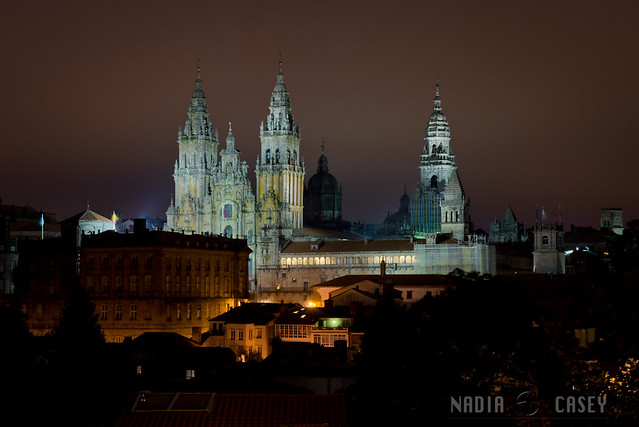
The Cathedral of Santiago de Compostela
The city of Santiago de Compostela is unquestionable one of Europe's most fantastic cities. We quickly became fascinated with its culture, history and architectural style, which is a mix of Romanesque, Gothic, and Baroque, combined with local influences that are both Spanish and modern urban-ism.
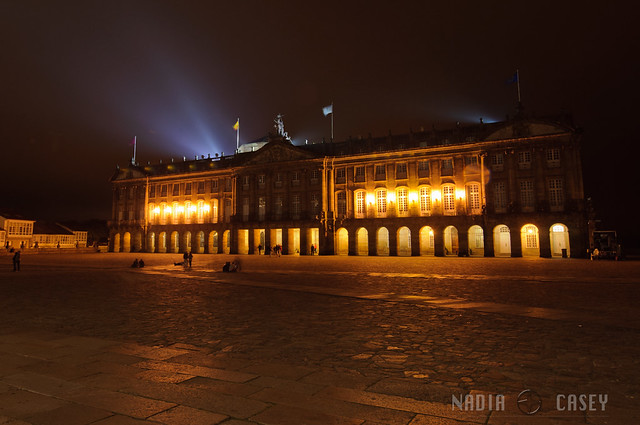
Praza do Obradoiro
Santiago de Compostela, Spain
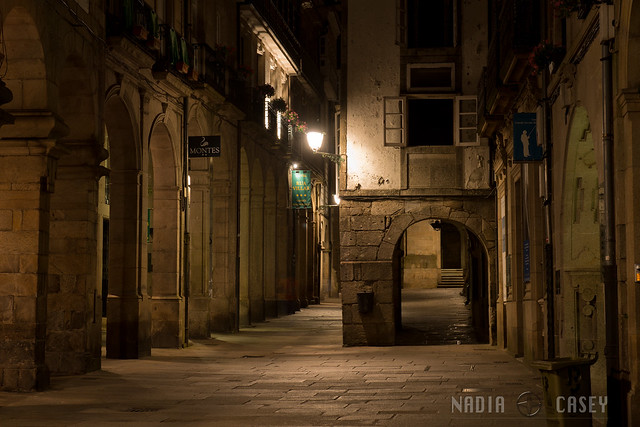
Quiet Street
Santiago Fountain
Hospedería San Martín Pinario
The most impressive piece of architecture is the Cathedral of Santiago de Compostela.
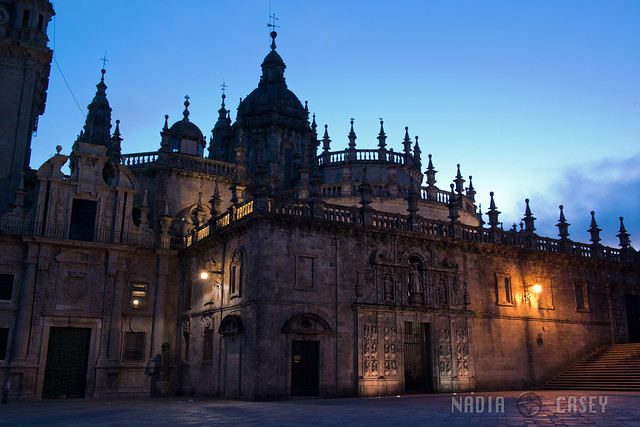
Cathedral Rear
In order to fully appreciate the city one has to understand a little of its history.
The
Apostle James (Santiago) went to the north-western part of
Spain to preach and convert people to Christianity. When he returned to
Palestine in 44 A.D., he was taken prisoner, tortured, and beheaded by
King Herod, which made him one of Christianity's first martyrs.
The legend is that after his death some of his disciples stole his body and sailed across
the Mediterranean Sea, through the Strait of Gibraltar and arrived in
Galicia. Once there they buried him in a wood called, in Latin, "Campus
Stellae", field of the star or Compostela.
It is
believed that his remains were found by the hermit Pelagius in 814 and a
chapel was built on the burial site. The recognition of the discovery
was first made by the King Alfonso II of Asturias and Galicia, who also
declared Saint James the patron of his empire, which gave the small
church further notoriety and prominence. Soon building and expansions
replaced the small church, Pilgrims began to follow the footsteps of
Santiago and eventually the original chapel became a cathedral.
Thus began the first pilgrimages to Santiago de Compostela in the 9th
and 10th centuries and their paths came to be known as El Camino de
Santiago the "Way of Saint James." It is claimed that Pope
Alexander III (1061-1073) declared it a Holy Town, and further that in
1122, Pope Calixtus II declared that the pilgrims who went to Santiago
in a Holy
Year (the years when the saint's day of the 25th of July fell on a
Sunday) should be free of all their sins, which considerably increased
the number of pilgrims to Santiago. Another benefit for pilgrims during a holy year is that they could
enter the Cathedral by a door designated as the “Holy Door”, which is
only opened during that year.
(The holy door is the gated door under the statue of St. James.)
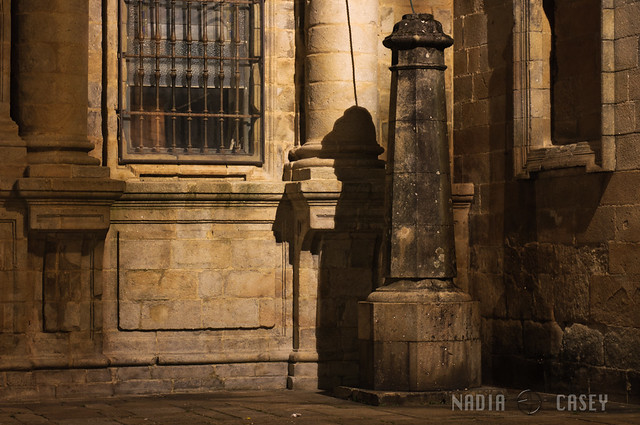
Pilgrim Pillar
This small "pillar" set in a corner of the exterior of the cathedral, is shaped and placed (perhaps coincidentally) in such a way that it casts a shadow that looks like a pilgrim. On the bottom left you can see the placement of this pillar in the previous photo of the Holy Door.

Tree of Jesse
Adding even more significance to the cathedral is that it is the final destination of the medieval pilgrimage, the Camino de Santiago, and a highlight of the pilgrimage is that one of the three rites that most pilgrims perform when they finally arrive, is to touch the column known as the Tree of Jesse.
The column is "the central pillar known as the Tree of Jesse, topped with a seated figure of a benign St James, carrying a pilgrim’s staff and a scroll which reads, “The Lord Sent Me”. Pilgrims over the last 1000 years have placed the fingers of their right hand into five indentations worn in the marble of this pillar, and said a silent prayer of thanks, or five Hail Marys for their safe arrival."
(Quote from Wendy Craig at caminoways.com)
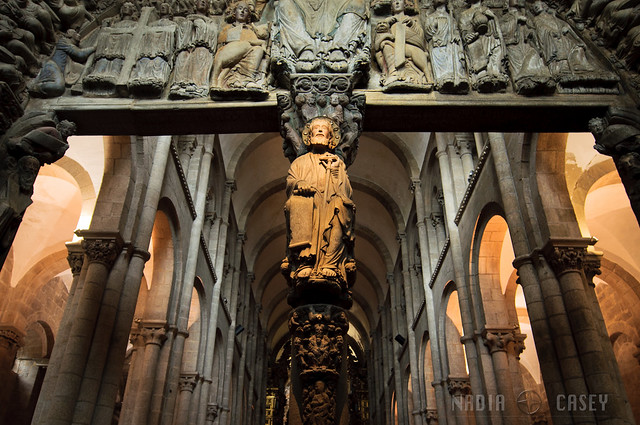
Tree of Jesse II

Romanesque Arches
These are the original Romanesque arches of the cathedral that was built starting in 1075, which was to replace the chapel that had been built over St. James burial site. Today most of the Baroque style you see on the facade and exterior of the cathedral is the result of several upgrades, most notable being the Facade of the Obradoiro completed in 1740.
The upper levels from where this photo was taken was used by medieval pilgrims as a place to sleep after their long journey.

Courtyard Corner
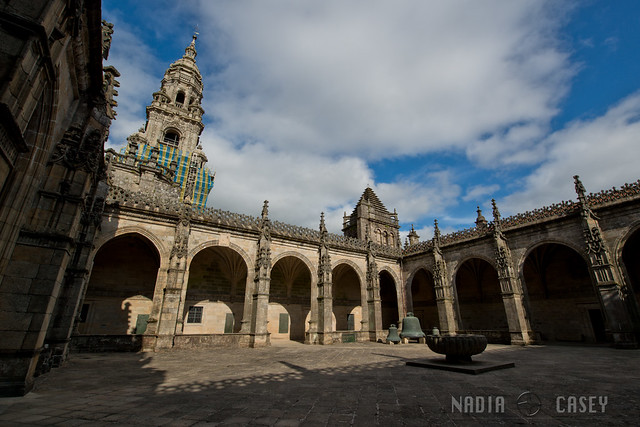
Cathedral Courtyard
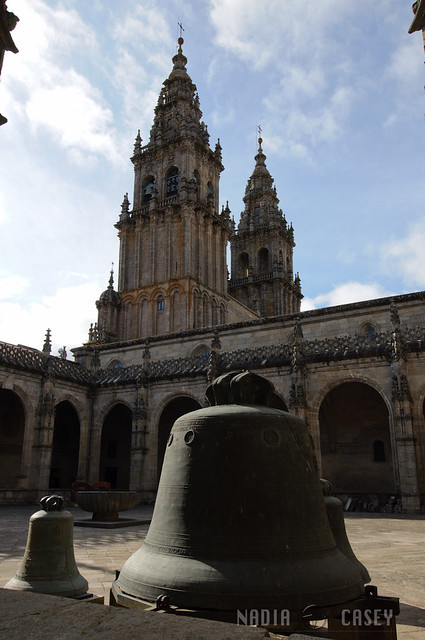
Bells & Tower
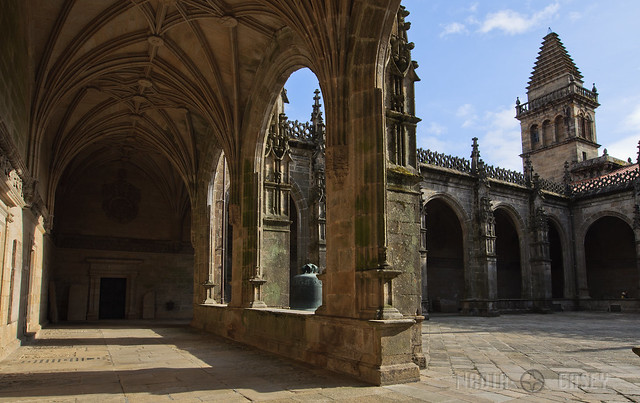
Courtyard Hall
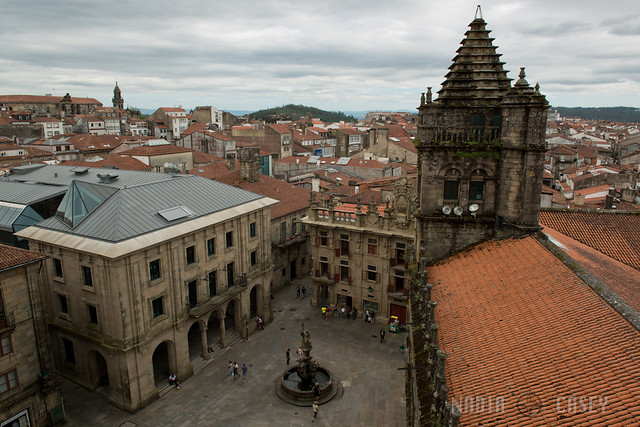
Above Cathedral Side Square
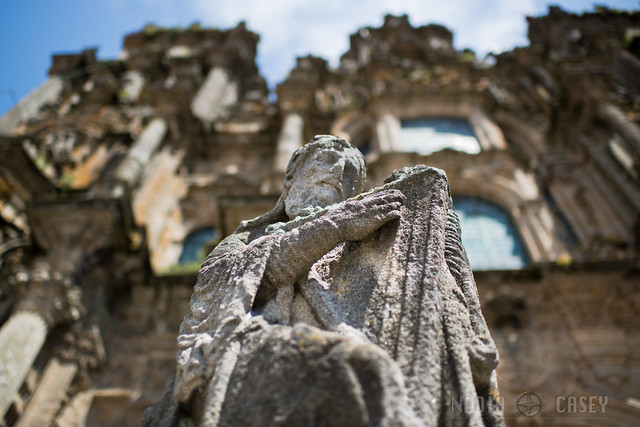
Cathedral Statue
Santiago de Compostela, Spain
~ The Botafumeiro ~
~ The Botafumeiro ~
Botafumeiro incense
Santiago de Compostela, Spain
The Botafumeiro is a famous thurible (which is a censer used in some ecclesiastical ceremonies) in the Santiago de Compostela Cathedral. This metal devise is suspended from chains, in which incense is burned and then this "incensory" is swung during a worship service. The name "Botafumeiro" means "smoke expeller" in Galician. It is carried and swung by eight men in red robes, called tiraboleiros and is believed by some that the use of a swinging censer in the Santiago de Compostela Cathedral began in the 11th century with arriving pilgrims who went straight to the Cathedral before washing from their journey. It was also believed that incense smoke had a preventative or protective effect from the plagues and epidemics during those eras.
Most cathedrals discontinued the use of their swinging censers over the years; one reasons being the fear of accidents. A famous accident took place in the Santiago de Compostela Botafumeiro while Princess Catherine of Aragon was visiting. In 1499, while on her way to be married to the heir of the English throne, she stopped at the cathedral in Santiago de Compostela. While it was being swung, the Botafumeiro flew out of the cathedral through the window. There are no reports of anyone being injured from that incident.
We had heard that Santiago de Compostela is very interesting and many people we had spoken to recommended that we visit. We didn't know much about it other than what we knew about the Camino de Santiago and that the Cathedral is impressive, but upon our arrival we quickly realized how wonderful this city is.
We started off in Madrid and drove North through Salamanca. Two days after that we went to A Coruña where we only spent one night. Then we took the coastline west, wrapping around the corner of the peninsula, before heading inland at Muros. We arrived late at night in Santiago and spend 2 days there. On the way back we spent the night in Avila. Avila and Salamanca are in Castile y León we will get to that later. We only had a week in Spain because we had to get ready for our trip to Southeast Asia, so we missed much of Galicia. All the more reason to go back.
Something you will see often in the countryside of the northwestern Iberian peninsula are the traditional granaries known as hórreos. We didn't get a chance to photograph them because of time constraints, but if you visit you'll see many of them and they are worth checking out.
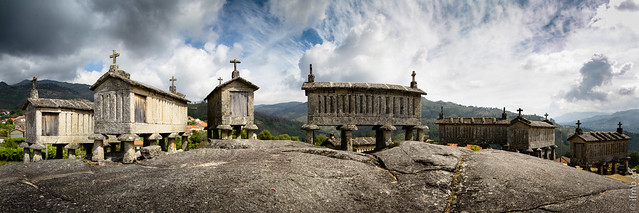
This photograph was taken in Soajo, Portugal by Marc Baertsch (© Marc Baertsch / All rights reserved), a wonderful photographer we met on flickr. You can view more of his superb work on his website.
Instants Figes - Marc Baertsch Photographies
If you're thinking about traveling to Spain and you want to see something that is a little out of the way, but rivals any region in Europe that we've seen to date, consider making a trip to Galicia.
The Edge of Europe
A Coruña, Spain
The most north-western part of Spain was called "Finis Terrae" by the Romans, the "end of the world."

View this album on flickr

View this album on flickr
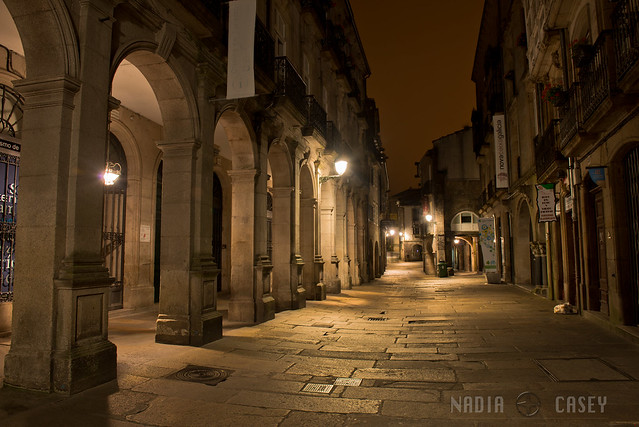
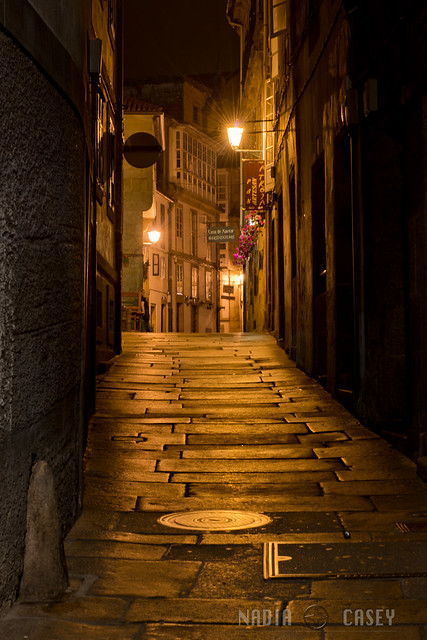

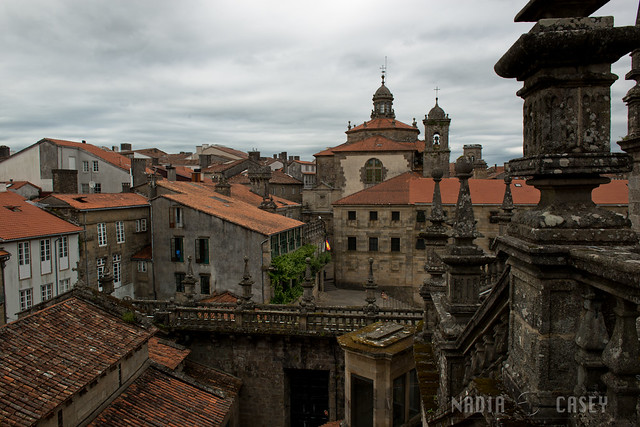
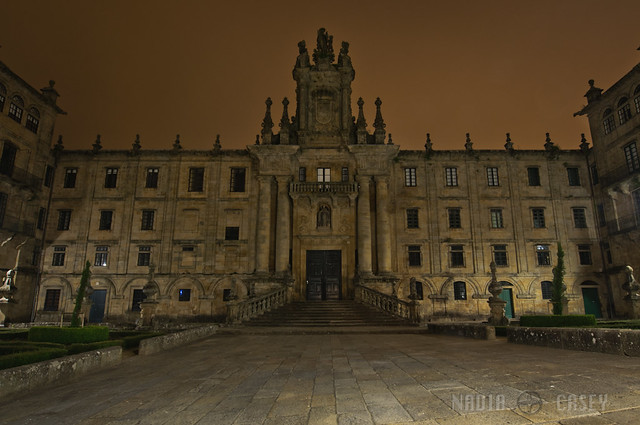
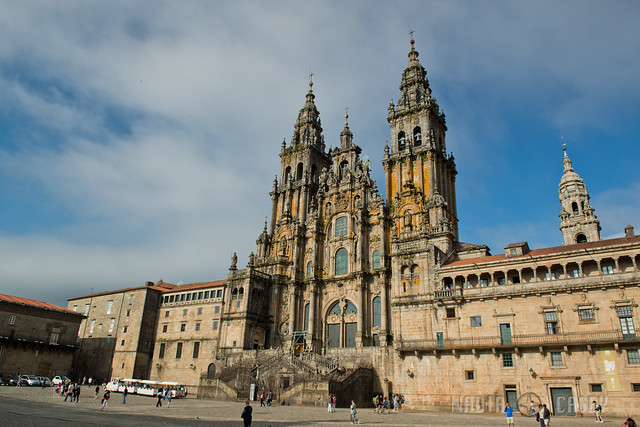
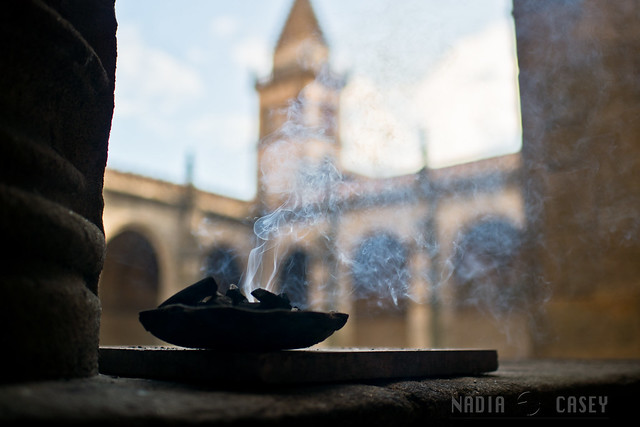
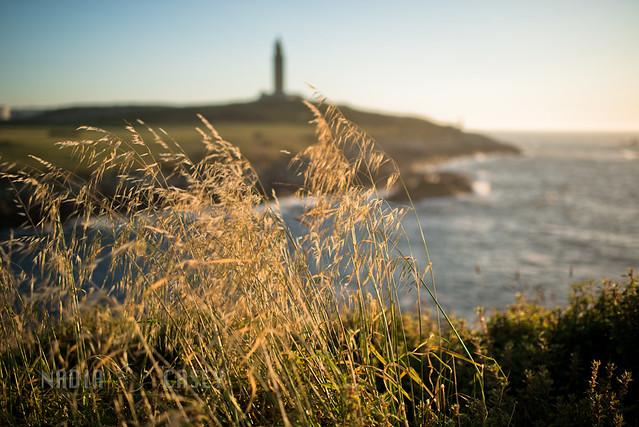
No comments:
Post a Comment